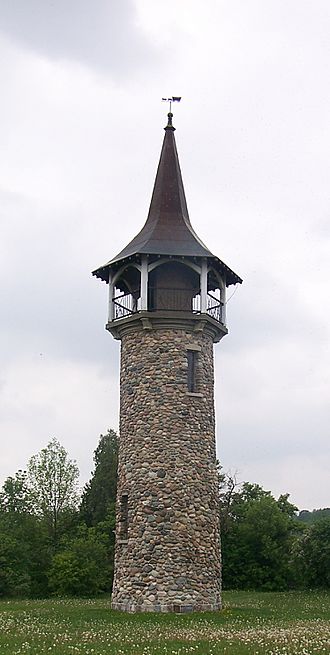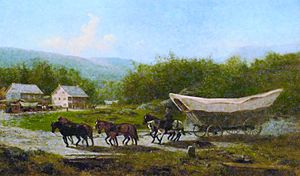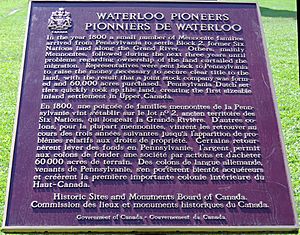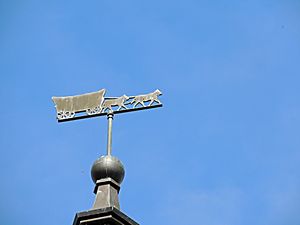Waterloo Pioneer Memorial Tower facts for kids
Quick facts for kids Waterloo Pioneer Memorial Tower |
|
|---|---|
 |
|
| General information | |
| Type | Memorial tower |
| Town or city | Kitchener, Ontario |
| Country | Canada |
| Coordinates | 43°24′01″N 80°24′58″W / 43.400142°N 80.416220°W |
| Inaugurated | 23 August 1926 |
| Owner | Parks Canada |
| Height | 18.9 metres (62 ft) |
| Technical details | |
| Material | Fieldstone |
| Design and construction | |
| Architect | William A. Langton |
The Waterloo Pioneer Memorial Tower is a special tower built in 1926 in Kitchener. It was created to remember the first Pennsylvania Dutch families who moved to Southwestern Ontario.
The idea for the tower came from William Henry Breithaupt. He wanted to help people in the city feel united again. During World War I, there were strong feelings against people of German background. This led to the city's name changing from Berlin to Kitchener.
The tower stands tall over the Grand River. This spot was first cleared by the early settlers. The tower's walls are made of natural stones. Its top has a weather vane shaped like a Conestoga wagon, which was a type of covered wagon used by pioneers.
This 18.9-metre (62-foot) tall tower is very important. In 1989, it was named a building of historical importance. It is a Classified Federal Heritage Building. It celebrates the arrival of the Pennsylvania-German pioneers between 1800 and 1803.
Contents
Why the Tower Was Built
Early Settlers Arrive
In the late 1700s and early 1800s, many Pennsylvania Dutch people moved to Ontario. They came from places like New York and Pennsylvania. They settled in areas such as York Region and the cities of Cambridge, Kitchener, and Waterloo.
Among the first to arrive were Samuel Betzner and Joseph Schoerg. They traveled over 700 kilometers (430 miles) in a Conestoga wagon. This long journey took them more than 10 weeks. They arrived in 1800 from Franklin County, Pennsylvania. They built their first homes in what is now part of Kitchener.
Joseph Schoerg and his wife settled near the Grand River. Samuel Betzner and his wife settled on the west bank of the Grand River. The farms built by their children still stand today on Pioneer Tower Road.
Kitchener's German Roots
By the early 1900s, the city of Berlin (now Kitchener) was known as "the German Capital of Canada." Many families of German descent lived there. The city even had a German-language newspaper. Schools taught German, and in 1911, 80% of elementary students took optional German classes. Products made in the city were often stamped with "Made in Berlin, Canada."
Changing the City's Name
During World War I, people started to feel less trusting of those with German heritage. The Berlin School Board stopped teaching German in schools. In 1916, the Berlin Board of Trade suggested changing the city's name. They felt the name was hurting business. They also believed a new name would show the residents' loyalty to Canada.
Even though some people did not want to change the name, a vote was planned for May 1916. Supporters of the name change worked hard to make sure it passed. There were strong feelings and disagreements in the city. On September 1, 1916, Berlin officially changed its name to Kitchener.
Building the Tower
In 1923, a group called the Waterloo County Pioneers' Memorial Association was formed. William Henry Breithaupt was the president of this group. He wanted to build a tower to remember the Mennonite pioneers. He also hoped it would help heal the city after the name change.
The Association bought a piece of land in January 1924. This land was once part of the Betzner family's property. Construction of the tower began in May 1925. William A. Langton from Toronto was the architect. The tower cost $4,500, which was raised by donations from many people.
The tower was officially opened on August 23, 1926. It honors the Pennsylvania Dutch (who were actually German-speaking) who settled the Grand River area. This area later became Waterloo County, Ontario.
What the Tower Looks Like
The tower was built on a spot cleared by Betzner's son. It stands on a ridge overlooking the Grand River. The tower is 18.9 meters (62 feet) tall and gets narrower towards the top.
It is made of rounded fieldstone. These stones were collected from the surrounding land over time. On top of the tower is a weather vane shaped like a Conestoga wagon. In 2009, the weather vane was fixed, and the copper roof was replaced.
The weather vane and roof design show the Swiss background of the early Pennsylvania Dutch settlers. The observation deck's design points to true north. It also reminds us of the Grand River Trail, which the first immigrants used to travel to the area.
The Tower's Importance Today
For many years, a picture of the tower was on the front page of the local newspaper, The Record. Important papers about the tower's creation and building are kept at the Kitchener Public Library.
In 1939, the Canadian government took over the tower's site. This happened because the Waterloo Historical Society did not have enough money to keep it up. Today, Parks Canada owns the tower. It is managed by the Woodside National Historic Site. The site is open to the public. You can visit the tower by asking for it to be opened.




